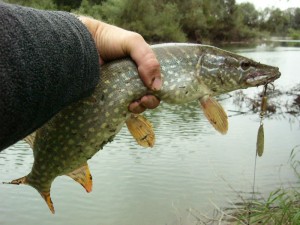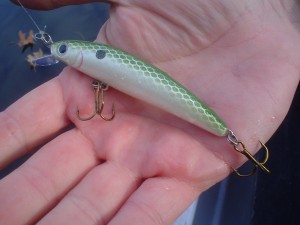Northern Pike, a fish with a mean face and the attitude to back it up. They are a highly aggressive fish that are a very popular game fish in the north. Fishing for northern pike has brought me many exciting fishing trips in the past and would offer the novice fisherman quite the fish story. The first time I caught a northern I honestly was surprised by its long length and vicious looking teeth. I refer to them as the freshwater barracuda. They are a very long and slender fish with a long snout and speckled brown spots down its body. At first I thought it was a snake with its long slender body. In any pursuit of a particular species it is good to have as many facts as you can about the particular fish you are in search for. Below are some general facts about northern pike.
General Facts about Northern Pike
The Latin name for norther pike is Esox Lucius.
Location:
They are generally found in the northern hemispheres. They are a very popular game fish in Canada, Russia, Northern Europe and Northern Asia. They can also be found as far south as West Virginia, Nebraska and Wyoming. I personally have landed nice northerns in Maine, New Hampshire, Vermont, Massachussetts and Rhode Island. Here are some lakes and ponds that I have cuaght northern pike. In Maine I have caught pike in Eagle Lake, Moosehead Lake, West Grand Lake, Flagstaff Lake and Sebago Lake. In Vermont I have landed some nice fish in Lake Champlain, Crystal Lake, Griffith Lake and Parker Lake. In Massachussetts Highland lakes, York Lake, Pelham lake, West Lake, Wallis Reservoir and Indian Lake. In Rhode island I have landed some decent northern pike from the Woonasquatucket Reservoir, Carbuncle Pond, Carr Pond, Lake Washington, Bowdish Reservoir, Waterman Reservoir, Worden Pond and Watchaug Pond. In general any large lake or pond in the northern part of the united states and Canada has the possibility of having a large jackfish (Northern Pike)
Appearance:
As stated above they are a very long fish with a protruding face. The colors vary based on the location, but in general they are a dark brown with tan spots. Its underside is generally light almost a white color. Its eyes are a very light shade of yellow. Its dorsal fin is generally located in the far back of its body. You can vividly see its sharp teeth when looking into its mouth. This is why I recommend using a steal leader, but I will discuss this in more detail below.
Lateral Line System:
Pike like many other fish species use the Lateral Line System to locate there prey. The lateral line system basically allows the pike to feel pressure differences in the water. Prey fish can cause these pressure differences while, swimming or struggling in the water. It also can detect faint electrical charges in the water. The length of the pike makes its lateral line system important as it can assist in determining the direction of its next food source. I will uses baits or fishing lures that take advantage of this fact. I will use bait and tackle that make much movement and cause as much vibration as possible while trolling or on the return.
Size:
They can grow quite large as the largest pike caught on record was 61lbs. A few years ago a 46lb pike was caught from Great Sacandaga lake in New York State. It is the largest freshwater predator in many of the states in the Northeast. When I want to impress a fellow freshwater fisherman I pursue northerns as they are by far the most impressive looking fish in terms of weight and length.
Habitat:
They are similar to Large-mouth or Small-mouth Bass in that they hide out in weedy areas waiting to ambush their prey. There long body’s make it easy for them to dart out and snatch their victims. I have good luck catching them wherever their is adequate cover and I rarely catch them in open areas of water. At one point I strictly fished in areas with many Lilly pads or overhanging brush, but I have learned that fishing areas much deeper with underwater growth produces even better results. They can sit and wait almost perfectly still along the long pond weeds on the bottom where they are very well camouflaged.
Reproduction:
Pike reproduce in the spring at 48 degrees fahrenheit. They head towards the shallower inlets of the lakes and ponds to reproduce. In the spring I generally head towards the shallower areas of the lake or pond. The bite seems to speed up when the water temperature gets above 46 degrees, but then dies off after 50 degrees. At least in Rhode Island I have noticed this.
Feeding Habits:
The younger northern pike generally feed in small isopods and insects when they are very small. They generally work their way up to larger and larger fish as they get older. They are also a cannibalistic species. Many anglers have had the experience of catching a smaller northern on the line only to have it bitten in half by a larger northern looking for a free meal. I generally use large shiners when fishing for northern pike, but some fellow anglers I know use pan fish. You could also use a small Bluegill or Crappie. For the best results use fresh bait, these Crappie Fishing Tips will help you to keep your baitwell full. From what I have read from other sources online is that they first attack their prey sideways and then swallow it head first. Small duckling have also been reported to be swallowed up by a larger northern.
My Personal Fishing Advice for Catching Northern Pike
When I fish for norther pike this is the essential tackle that I bring.
-
A Large Net
- Large plugs
- Large spinners or rooster tails
- Large Spoons or Cyclops
- Large Swim Baits
- Rubber Worms
- Wire Leader
- I buy the largest shiners or pin heads that the bait store has to offer.
- Needle Nose Pliers
- Thick Fishing Gloves that will offer you hands protection if bitten by a larger pike.
Depending upon the lake and time of the season I try to find one of the deepest parts of the lake that I believe has weeds or other cover on the bottom. I rig a dropper loop in my line a few feet from the bottom. I attach the wire leader to the dropper loop and attach a medium size eagle claw or similar hook to the leader. At the bottom of the line I attach a 1 to 2 ounce sinker depending upon the depth of the water I am fishing. I then place my shiner on the hook. Sometimes I will also place multiple hooks to my line depending apon how well the current location in producing.
In the past I have caught northern pike fishing the top with a float dober, quite unexpectedly I might add, but it is generally in the sping when they are spawning.
In general I try to use bait or plugs that make much vibration in the water taking advantage of the pikes long lateral line sensors. I spend less time focusing on fishing smells and more time focusing trying to find lures or bait that will be visually appealing to pike and/or make a lot of movement in the water. The steal leader that I use does not seem to distract the fish, but in very clear conditions I have placed a very heavy lead line instead of the steel leader. I am not totally sure if this made a substantial difference, but I have landed fish using either technique. In the spring I generally use more topwater plugs as they are closer to the surface at that time.
I do not often Ice fish in Rhode Island but I have seen many anglers Ice fish in that area for Northern Pike. They use large shiners or other large bait. Suppossidly there was a 15lb pike that was caught in the Woonasquatucket Reservoir just last year. This body of water is not very deep, but does have running water through it. As long as thier is a plentifull food source you will be amazed at how large some fish can grow in shallow waters.
If I decide to use artificial plugs I use the largest ones I have for freshwater (Sometimes even a small saltwater plug). I have a few that resemble a small pike that seem to be effective. Also rubber worms have attendance to work well in areas where there is heavy weed cover. Large rooster tail produce well near lily pads and/or other debris.
When you do land your first northern pay attention to there large sharp teeth, be certain not to place your fingers in there mouth. Many friends of mine have received bad bites in the past. Always use your needle nose pliers.
I hope that you will find this posting informative and helpful for your next northern pike fishing adventure.


